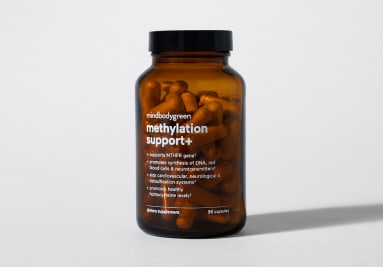This Little-Known Risk Factor Can Increase Your Dementia Risk By 31%


We've been looking into dementia a lot lately—specifically, how to spot cognitive decline and what you can do to prevent it in the first place. In my research, I've noticed one major risk factor that isn't discussed very often: high homocysteine levels.
What to know about elevated homocysteine levels
Homocysteine is an amino acid that's heavily involved in a biological process called methylation. During methylation, the bioactive form of folate (5-MTHF) donates a methyl group to homocysteine so it can be converted into another amino acid, methionine. When operating optimally, methylation promotes cardiovascular, neurological, and reproductive health; aids energy production; bolsters detoxification pathways; supports longevity; and more.
The problem is that more than 50% of the U.S. population has a genetic mutation of the MTHFR gene that inhibits the body's ability to activate folate, so it can't optimize methylation. If bioactive folate isn't available to help convert homocysteine during the methylation cycle (i.e., due to an MTHFR gene variation or other reasons—such as poor diet, hormone imbalances, stress, or exposure to toxins), homocysteine levels can become too high.
Elevated homocysteine levels are linked to a higher risk of chronic inflammation, poor detoxification, cardiovascular disease, autoimmune conditions, and yes—dementia.
Homocysteine and dementia risk
Evidence suggests that elevated homocysteine levels are one of the causes of age-related decline and a dementia risk factor—but it's a modifiable risk, meaning our lifestyle habits can optimize our homocysteine levels and subsequently, reduce our dementia risk.
In a 2018 Journal of Alzheimer's Disease review, researchers analyzed a number of meta-analyses and found that 12% to 31% of dementia cases could be prevented by lowering fasting total homocysteine (tHcy) levels. (And their science-backed suggestion for optimizing homocysteine levels is more simple than you might think.)
How to maintain healthy homocysteine levels
Scientists from the 2018 review found that elderly adults with cognitive impairment that increased their intake of methylation-critical B vitamins (i.e., folate, B6, and B12) saw a slowed rate of cognitive decline. mindbodygreen's founder and co-CEO, Jason Wachob, was able to get his own elevated homocysteine levels down to a healthy range with a combination of these nutrients, plus riboflavin (vitamin B2) and betaine.
If you increase your B vitamin intake through supplementation, make sure to get bioactive B vitamins (e.g., methylated folate and B12) to ensure your body is able to use your B's, even if you're a part of the 50% that have an MTHFR gene variation.
The takeaway
Dementia cases are on the rise worldwide, but you don't have to become another statistic. By optimizing your homocysteine levels (ideally, with an increase in methylation-critical B vitamins), you can ensure your methylation cycle is operating optimally and reduce your risk of dementia by up to 31%.

Morgan Chamberlain is a supplement editor at mindbodygreen. She graduated from Syracuse University with a Bachelor of Science degree in magazine journalism and a minor in nutrition. Chamberlain believes in taking small steps to improve your well-being—whether that means eating more plant-based foods, checking in with a therapist weekly, or spending quality time with your closest friends. When she isn’t typing away furiously at her keyboard, you can find her cooking in the kitchen, hanging outside, or doing a vinyasa flow.

